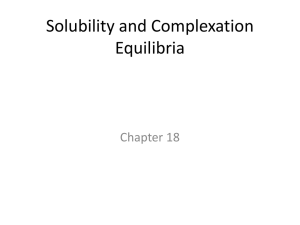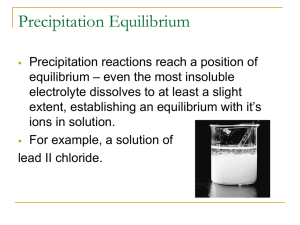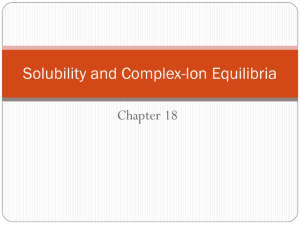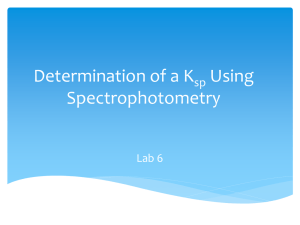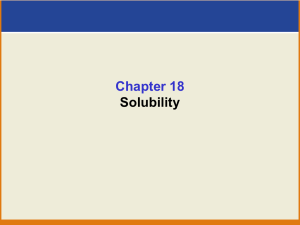The Solubility Product Constant, K sp
advertisement
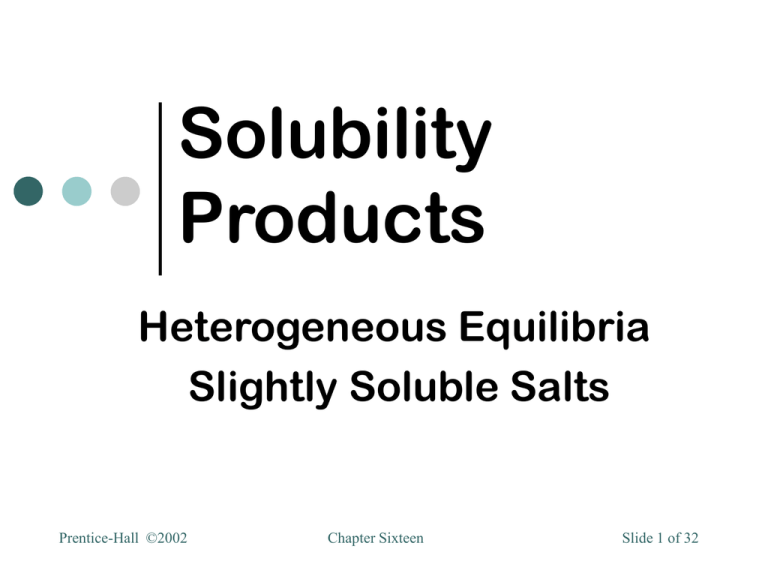
Solubility Products Heterogeneous Equilibria Slightly Soluble Salts Prentice-Hall ©2002 Chapter Sixteen Slide 1 of 32 Solubility of Ionic Salts The solubility of ionic salts varies considerably. Most nitrates are very soluble, while phosphates and may other salts of transition metal ions are often insoluble. Slide 2 of 36 Solubility and Temperature The solubility of ionic salts varies considerably with the temperature. Some salts such as KNO3 have a wide solubility range. On the other hand, the solubility of NaCl in water varies only slightly. Slide 3 of 36 The Solubility Product Constant, Ksp Many important ionic compounds are only slightly soluble in water and equations are written to represent the equilibrium between the compound and the ions present in a saturated aqueous solution. The solubility product constant, Ksp, is the product of the concentrations of the ions involved in a solubility equilibrium, each raised to a power equal to the stoichiometric coefficient of that ion in the chemical equation for the equilibrium. Slide 4 of 36 The Solubility Equilibrium Equation And Ksp Example 1 CaF2 (s) Ca2+ (aq) + 2 F- (aq) Ksp = [Ca2+][F-]2 Ksp = 5.3x10-9 Example 2 As2S3 (s) 2 As3+ (aq) + 3 S2- (aq) Ksp = [As3+]2[S2-]3 Ksp = 4.4 x10-27 Slide 5 of 36 Some Values For Solubility Product Constants (Ksp) At 25 oC Slide 6 of 36 Ksp And Molar Solubility The solubility product constant is related to the solubility of an ionic solute, but Ksp and molar solubility - the molarity of a solute in a saturated aqueous solution - are not the same thing. Calculating solubility equilibria fall into two categories: determining a value of Ksp from experimental data calculating equilibrium concentrations when Ksp is known. Slide 7 of 36 Calculating Ksp From Molar Solubility It is found that 1.2x10-3 mol of lead (II) iodide, PbI2, dissolves in 1.0 L of aqueous solution at 25 oC. What is the Ksp at this temperature? PbI2 (s) Pb2+ (aq) + 2 I- (aq) Ksp = [Pb2+] [I-]2 For every lead iodide that dissolves there is one lead ion and 2 iodide ions. Therefore [Pb2+] = 1.2x10-3 [I-] = 2.4x10-3 Ksp =(1.2x10-3)(2.4x10-3)2 = 6.9 x 10-9 Slide 8 of 36 Calculating Molar Solubility From Ksp Calculate the concentration of [Ag+] and [Cl-] in a saturated solution of silver chloride. The ksp for silver chloride : Ksp = 1.8x10-10 Ksp = [Ag+] [Cl-] = 1.8x10-10 Let x = [Ag+] = [Cl-] . Substitute into the Ksp expression x2 = 1.8x10-10 x = 1.8x10-10 =1.34 x 10-5 [Ag+] = [Cl-] =1.34 x 10-5 Slide 9 of 36 Calculating Molar Solubility From Ksp Calculate the molar solubility of silver chromate, Ag2CrO4, in water from Ksp = 1.1x10-12 for Ag2CrO4. Ag2CrO4 (s) 2 Ag+ + CrO42Ksp = [Ag+]2 [CrO42-] = 1.1x10-12 Let x = [CrO42-] 2x = [Ag+] Substitute into the Ksp expression 4x3 = 1.1x10-12 x = 3 1.1x10-12 /4 x = [CrO42-] = 6.5 x10-5 2x = [Ag+] = 1.30 x 10-4 Slide 10 of 36 The Common Ion Effect In Solubility Equilibria The common ion effect also affects solubility equilibria. Le Châtelier’s principle is followed for the shift in concentration of products and reactants upon addition of either more products or more reactants to a solution. The solubility of a slightly soluble ionic compound is lowered when a second solute that furnishes a common ion is added to the solution. The common ion effect is frequently used in analytical chemistry to determine such things as the percent of an element present in an unknown sample. Slide 11 of 36 Solubility Equilibrium Calculation -The Common Ion Effect What is the solubility of Ag2CrO4 in 0.10 M K2CrO4? Ksp = 1.1x10-12 for Ag2CrO4. Let 2x = Ag+ and CrO42- = 10-1 (4x2)(10-1) = 1.1 x 10-12 4x2 = 1.1 x 10-12/ 10-1 = 1.1 x 10-11 [Ag+] = 2x = 3.32 x 10-6 x = 1.66 x 10-6 Comparison of solubility of Ag2CrO4 In pure water: 6.5 x 10-5 M In 0.10 M K2CrO4: 1.7 x 10-6 M The common ion effect!! Slide 12 of 36 Determining Whether Precipitation Occurs Qip is the ion product reaction quotient and is based on initial conditions of the reaction. Qip can then be compared to Ksp. To predict if a precipitation occurs: - Precipitation should occur if Qip > Ksp. - Precipitation cannot occur if Qip < Ksp. - A solution is just saturated if Qip = Ksp. Slide 13 of 36 Determining Whether Precipitation Occurs – Example 1 How many grams of KI should be dissolved in 10.0 dm-3 of 0.00200 M Pb(NO3)2 solution so that precipitation of PbI2 (s) will just begin? PbI2 Pb2+ (aq) + 2 I- (aq) Ksp = [Pb2+] [I-]2 = 7.1 x 10-9 [Pb2+] = 2.00 x 10-3 so [I-]2 = (7.1 x 10-9)/(2.0 x 10-3) [I-]2 = 3.55 x 10-6 [I-] = 1.88 x 10-3 mol dm-3 (1.88 x 10-3 mol dm-3) (10.0 dm3) = 1.88 x10-2 mol (1.88 x10-2 mol) (166.00 g mol-1KI) = 3.12 g Slide 14 of 36 Determining Whether Precipitation Occurs –Example 2 The concentration of calcium ion in blood plasma is 0.0025 M. If the concentration of oxalate ion is 1.0x10-7 M, do you expect calcium oxalate to precipitate? Ksp = 2.3x10-9. CaC2O4 Ca2+ (aq) + C2O42- (aq) [Ca2+ ] [C2O42- ] = 2.3x10-9 Three steps: (1) Determine the initial concentrations of ions. (Put both in the Ksp formula) (2) Evaluate the reaction quotient Qip. (3) Compare Qip with Ksp. If Qip > Ksp then it will precipitate Slide 15 of 36 Determining Whether Precipitation Occurs – Another Example In applying the precipitation criteria, the effect of dilution when solutions are mixed must be considered. Example: A 250.0 mL sample of 0.0012 M Pb(NO3)2 (aq) is mixed with 150.0 mL of 0.0640 M NaI (aq). Should precipitation of PbI2 (s), Ksp = 7.1x10-9, occur? Slide 16 of 36 Determining Whether Precipitation Is Complete A slightly soluble solid never totally precipitates from solution, but we generally consider precipitation to be essentially complete if about 99.9% of the target ion is precipitated and only 0.1% or less is left in solution. Three conditions that generally favor completeness of precipitation are: A very small value of Ksp. A high initial concentration of the target ion. A concentration of common ion that greatly exceeds that of the target ion. Slide 17 of 36 Determining Whether Precipitation Is Complete An Example A 0.50 L solution of 0.0010 M BaCl2 is added to 0.50 L solution of 0.00010 M Na2SO4. Will the precipitation of SO42- as BaSO4 (s) be complete? Ksp = 1.1x10-10. Slide 18 of 36 Selective Precipitation a) The first precipitate to form when AgNO3(aq) is added to an aqueous solution containing Cland I- is yellow AgI(s). b) Essentially all the I- has precipitated before the precipitation of white AgCl(s) begins. Slide 19 of 36 Selective Precipitation An Example Example 16.10 An aqueous solution that is 2.00 M in AgNO3 is slowly added from a buret to an aqueous solution that is 0.0100 M in Cl- and also 0.0100 M in IAgCl (s) Ag+ (aq) + Cl- (aq) a. b. c. Ksp = 1.8x10-10 AgI (s) Ag+ (aq) + I- (aq) Ksp = 8.5x10-17 Which ion. Cl- or I-, is the first to precipitate from solution? When the second ion begins to precipitate, what is the remaining concentration of the first ion? Is separation of the two ions by selective precipitation feasible? Slide 20 of 36 Effect of pH on Solubility The solubility of an ionic solute may be greatly affected by pH if an acid-base reaction also occurs as the solute dissolves. If the anion of the precipitate is that of a weak acid, the precipitate will dissolve somewhat when the pH is lowered; if, however, the anion of the precipitate is that of a strong acid, lowering the pH will have no effect on the precipitate. Since CO2 is lost from the reaction of an insoluble carbonate with acid, this concept does not apply. Slide 21 of 36 Effect of pH on Solubility - An Example Determine the molar solubility of Fe(OH)3 in pH = 2.70 buffer. Ksp = 4.0x10-38 for Fe(OH)3. Slide 22 of 36 Qualitative Inorganic Analysis Acid-base chemistry, precipitation reactions, oxidationreduction, and complex-ion formation all come into sharp focus in an area of analytical chemistry called classical qualitative inorganic analysis. “Qualitative” signifies that the interest is in determining what is present, not how much is present. Although classical qualitative analysis is not as widely used today as instrumental methods, it is still a good vehicle for applying all the basic concepts of equilibria in aqueous solutions. Slide 23 of 36 Slide 24 of 36 Cations of Group 1 If aqueous HCl is added to an unknown solution of cations, and a precipitate forms, then the unknown contains one or more of these cations: Pb2+, Hg22+, or Ag+. These are the only ions to form insoluble chlorides. If there is no precipitate, then these ions must be absent from the mixture. If there is a precipitate, it is filtered off and saved for further analysis. The supernatant liquid is also saved for further analysis. Slide 25 of 36 Cation Group 1 (continued) Analyzing For Pb2+ Of the three possible ions in solution, PbCl2 is the most soluble in water. The precipitate is washed with hot water and the washings then treated with aqueous K2CrO4. If Pb2+ is present, chromate ion combines with lead ion to form a precipitate of yellow lead chromate, which is less soluble than PbCl2. If Pb2+ is absent, then the washings just become tinged yellow but no precipitate is in evidence. Slide 26 of 36 Cation Group 1 (continued) Analyzing For Ag+ Next, the undissolved precipitate is treated with aqueous ammonia. If AgCl is present, it will dissolve in this solution. If there is any remaining precipitate, it is separated from the supernatant liquid and saved for further analysis. The supernatant liquid (which contains the Ag+, if present) is then treated with aqueous nitric acid. If a precipitate reforms, then Ag+ was present in the solution, if no precipitate forms, then Ag+ was not present in the solution. Slide 27 of 36 Cation Group 1 (continued) Analyzing For Hg22+ When precipitate was treated with aqueous ammonia in the previous step, any Hg22+ underwent an oxidation-reduction reaction to form a dark gray mixture of elemental mercury and HgNH2Cl that precipitates from the solution. If this dark gray precipitate was observed, then mercury was present in the original unknown sample. If this dark gray precipitate was not observed, then mercury must have been absent from the Slide 28 of 36 original unknown sample. Group 1 Cation Precipitates left: cation goup 1 ppt: PbCl2, PbCl2, AgCl (all white) middle: product from test for Hg22+: mix of Hg (black) and HgNH2Cl (white) right: product from test for Pb2+: PbCrO4 (yellow) when K2CrO4(aq) is reacted with saturated PbCl2 Slide 29 of 36 Slide 30 of 36 Hydrogen Sulfide In The Qualitative Analysis Scheme H2S is a weak diprotic acid; there is very little ionization of the HS- ion and it is the precipitating agent. H2S (aq) + H2O H3O+ (aq) + HS- (aq) Ka1 = 1.0x10-7 HS- (aq) + H2O H3O+ (aq) + S2- (aq) Ka2 = 1.0x10-19 H2S (aq) + H2O H3O+ (aq) + HS- (aq) MS (s) + H3O+ (aq) M2+ (aq) + H2S (aq) + 2 H2O (l) MS (s) + 3 H3O+ M2+ (aq) + HS- (aq) + H2O (l) Overall: (aq) Slide 31 of 36 Cation Groups 2, 3, 4 And 5 The concentration of HS- is so low in a strongly acidic solution, that only the most insoluble sulfides precipitate. These include the eight metal sulfides of Group 2. Of the eight cations in Group 3, five form sulfides that are soluble in acidic solution but insoluble in an alkaline ammonia/ammonium chloride buffer solution. The other three group 3 cation form hydroxide precipitates in the alkaline solution. The cations of groups 4 and 5 form soluble sulfides, even in basic solution. Slide 32 of 36 Slide 33 of 36 Cation Groups 2, 3, 4 And 5 The hydroxides of Groups 4 and 5, with the exception of Mg2+, are also moderately or highly soluble. The group 4 cations are precipitated as carbonates from a buffered alkaline solution. The cations of group 5 remain soluble in the presence of all common reagents. Within each of the qualitative analysis groups, additional reactions to dissolve group precipitates and to separate and selectively precipitate individual cations for identification and confirmation are used. Slide 34 of 36 Summary The solubility product constant, Ksp, represents equilibrium between a slightly soluble ionic compound and its ions in a saturated aqueous solution. The common ion effect is responsible for the reduction in solubility of a slightly soluble ionic compound. Precipitation is assumed to be complete if no more than 0.1% of the target ion remains in solution. The solubilities of some slightly soluble compounds depends strongly on pH. Slide 35 of 36 Summary Precipitation, acid-base, and oxidation-reduction reactions, together with complex-ion formation, are all used extensively in the classical scheme for the qualitative analysis of common cations. Slide 36 of 36
